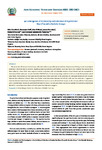An Investigation of the Sociality and Behaviour of Captive Polar Bears Housed in Bachelor Groups
| dc.contributor.author | Cavalleri, A | |
| dc.contributor.author | Bell, A | |
| dc.contributor.author | Wilkins, K | |
| dc.contributor.author | Brereton, J | |
| dc.contributor.author | Preziosi, Richard | |
| dc.contributor.author | Quintavalle Pastorino, G | |
| dc.date.accessioned | 2023-01-16T14:34:33Z | |
| dc.date.available | 2023-01-16T14:34:33Z | |
| dc.date.issued | 2022-02-15 | |
| dc.identifier.issn | 2582-3183 | |
| dc.identifier.issn | 2582-3183 | |
| dc.identifier.uri | http://hdl.handle.net/10026.1/20173 | |
| dc.description.abstract |
The polar bear (Ursus maritimus) is a popular and easily recognisable species and has a long history of being housed in zoological collections. However, due to concerns regarding space requirements and welfare, many zoos have since removed this species from their collection plans. Polar bears require spacious enclosures with considerable amounts of enrichment and are susceptible to stereotypy if their needs are not met. Yorkshire Wildlife Park, UK, has set up a large enclosure to demonstrate best-practice care of polar bears. Observations of four male captive polar bears were conducted at the collection, to investigate behaviour and sociality between the individuals. Overall, there was limited social interaction between individuals, with very few instances of aggression observed between individuals. Stereotypical behaviour was also rare in all individuals except one. By contrast, affiliative interactions were observed more frequently, particularly between two bears. Overall, polar bears may possess greater behavioural plasticity and flexibility in social behaviour than wild and captive bear literature suggests. | |
| dc.format.extent | 18-25 | |
| dc.language.iso | en | |
| dc.publisher | Acta Scientific Publications Pvt. Ltd. | |
| dc.title | An Investigation of the Sociality and Behaviour of Captive Polar Bears Housed in Bachelor Groups | |
| dc.type | journal-article | |
| plymouth.issue | 3 | |
| plymouth.volume | 4 | |
| plymouth.publication-status | Published online | |
| plymouth.journal | Acta Scientific Veterinary Sciences | |
| dc.identifier.doi | 10.31080/asvs.2022.04.0325 | |
| plymouth.organisational-group | /Plymouth | |
| plymouth.organisational-group | /Plymouth/Faculty of Science and Engineering | |
| plymouth.organisational-group | /Plymouth/Faculty of Science and Engineering/School of Biological and Marine Sciences | |
| plymouth.organisational-group | /Plymouth/REF 2021 Researchers by UoA | |
| plymouth.organisational-group | /Plymouth/REF 2021 Researchers by UoA/UoA07 Earth Systems and Environmental Sciences | |
| plymouth.organisational-group | /Plymouth/Users by role | |
| plymouth.organisational-group | /Plymouth/Users by role/Academics | |
| dcterms.dateAccepted | 2022-02-01 | |
| dc.rights.embargodate | 2023-2-11 | |
| dc.identifier.eissn | 2582-3183 | |
| rioxxterms.versionofrecord | 10.31080/asvs.2022.04.0325 | |
| rioxxterms.licenseref.uri | http://www.rioxx.net/licenses/all-rights-reserved | |
| rioxxterms.type | Journal Article/Review |


